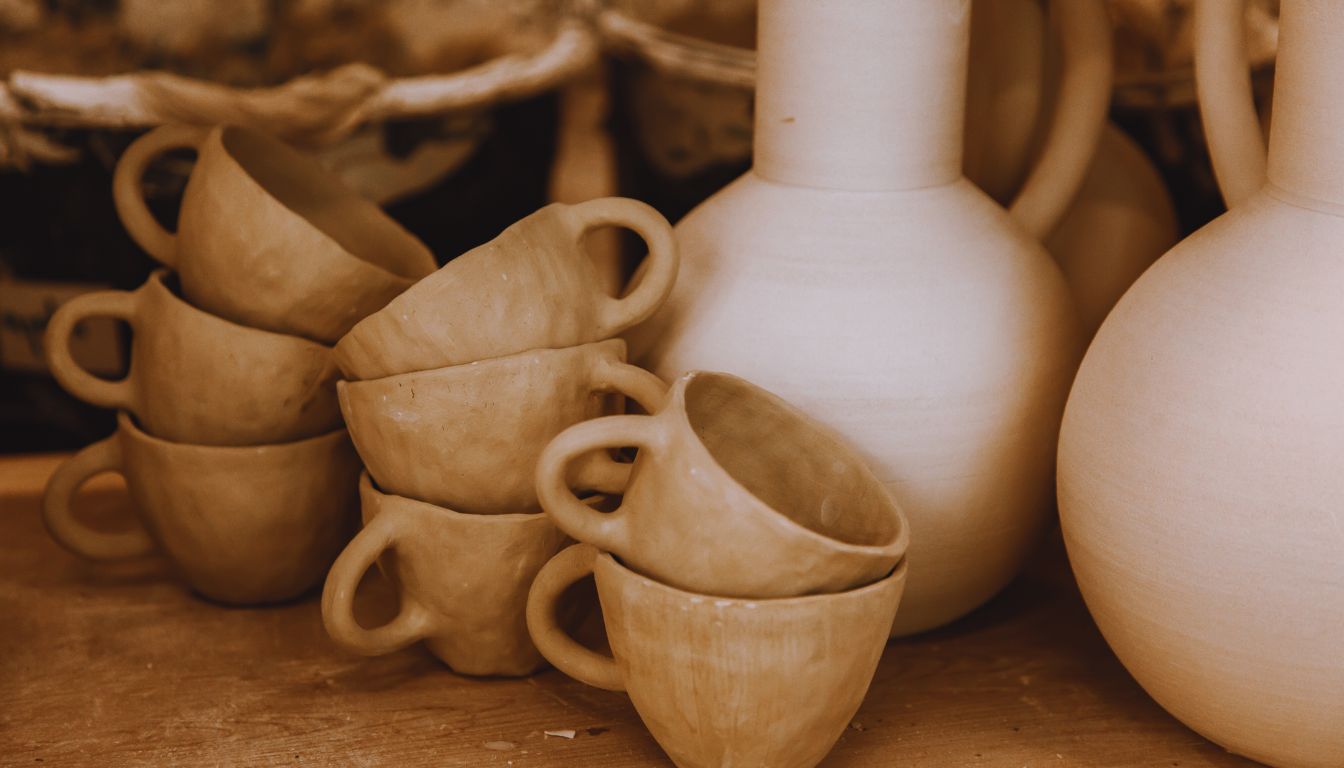Greek art has deeply influenced our world with its beauty and lasting impact. It includes stunning Ancient Greek Pottery, like the famous Athenian Vases and detailed Amphoras. It also features sculptures that set new standards for beauty. This article takes you on a journey through Greek art history, highlighting key periods and iconic works.
The Ancient Greek Pottery techniques, such as Red-Figure Pottery and Black-Figure Pottery, show the skill of these ancient people. These pots were more than just containers. They were canvases for beautiful designs and stories from Greek myths, giving us a peek into their rich culture.
Table of Contents
Marveling at the Parthenon: An Architectural Triumph
The Parthenon sits atop the Acropolis of Athens, a true marvel of ancient Greek architecture. Built in the 5th century BCE, it shows off perfect proportions, detailed decorations, and intricate carvings. These tell stories of a long-lost time.
The columns are more than just stone and mortar. They are the heart of the Acropolis, showing the ancient Greeks’ skill and creativity.
The Parthenon’s creation is a remarkable engineering achievement. The builders used new techniques and materials to make it last for centuries. They used gypsum, a mineral from ancient seas, for its strength.
This gypsum, also known as plaster of Paris, was common in ancient Greek art. The Greek philosopher Theophrastus wrote about it.
The Parthenon’s columns were made to stand strong against earthquakes. They have survived many quakes, with only a tiny bit of movement. This design, along with Pericles’s big project at the Acropolis, has made the Parthenon a lasting symbol of ancient Greek architecture.
Unearthing Pottery’s Tales: From Vases to Daily Life

Step beyond the temple walls, and you’ll find a world of Ancient Greek pottery and vases. These vessels show us stories from the past. They give us a peek into the daily lives and culture of ancient Greeks.
Pottery fragments, or sherds, are tough and last long. By studying pottery styles, archaeologists can date sites and learn about cultures. They see how technology and resources changed over time.
Pottery is a treasure trove for archaeologists, full of information. They use methods like typology and thermoluminescence dating. This helps them understand ancient beliefs, food, and trade.
The eBook “Greek Vase-painting,” published in 1921, is a key work. Scholars like Mr. J.D. Beazley and Mr. J.C. Hoppin have made big contributions. Their work on early red-figured vases shows the beauty of Greek art.
Polykleitos: The Sculptor of Perfection
Polykleitos was a giant in ancient Greek sculpture. He is known for his exacting precision. His work, the “canon,” is still a guide for the perfect human form.
In the 5th century BCE, Polykleitos worked alongside famous sculptors like Pheidias and Myron. He aimed for perfection in his art. His lost treatise, “Canon of Polykleitos,” showed the math behind the ideal male body.
His famous statue, the Doryphoros, shows his focus on beauty and math. It’s a study of the perfect human shape. People have admired it for centuries.
Polykleitos greatly influenced the Classical Greek style. He and others, like Phidias, paid close attention to details. Their work, like the Roman marble copies of Polykleitos’ statues, still impresses us today.
Polykleitos’ “Canon” and his sculptures still inspire artists and scholars. His dedication to the perfect human form and his use of math in beauty have made him a legend in ancient Greek art.
Ancient Greek Pottery: Four Pivotal Eras
Start an exciting journey through ancient Greek pottery’s four key periods. Each era shows the art’s amazing growth and variety. From the Geometric era’s geometric designs to the Hellenistic era’s emotional expressions, each period has its own unique style.
The Geometric pottery, from around 900 BCE, is known for its bold lines and shapes. It reflects the artistic tastes of the Dark Ages. The Archaic period brought more realistic designs, with vases showing myths and everyday life.
The Classical era focused on perfection, leading to the black-figure and red-figure pottery techniques. The black-figure style was popular for over 150 years. Then, around 530 BCE, the red-figure style became more common, staying popular for a century and a half.
The Hellenistic period was a time of cultural growth and new artistic styles. Hellenistic potters created more emotional and dynamic pieces. Their work still fascinates people today.
These four eras in ancient Greek pottery have greatly influenced the region’s art. They give us a peek into the creative minds and stories that shaped these timeless works.
Fresco Paintings: Canvases of Ancient Greece
Explore the world of ancient Greek fresco paintings. These works show the artistry of the past in bright colors and detailed designs. They give us a glimpse into the myths, daily life, and beliefs of ancient Greece.
The art of fresco painting flourished in ancient Greece. It spanned from the Archaic to the Classical periods. During this time, artists used black- and red-figure techniques to decorate pottery, especially in Athens.
These paintings were more than just decorations. They showed different parts of Athenian life, from everyday activities to special events. The texts, inscriptions, and pictures on these vases give us a deep look into the culture and art of that time.
The fresco tradition in ancient Greece also includes the Minoan civilization. Works like the Dolphin Fresco from Knossos, Crete, show the beauty of Minoan culture. The Akrotiri wall paintings and the Papyrus Fresco from Thera add to the richness of ancient Greek fresco art.
These fresco paintings, from ancient Greece to the Roman era, still amaze and inspire today. They are a testament to the artistic brilliance of the ancient world.
Goya’s Brush: Reflecting an Era
Francisco de Goya’s art shines brightly from the late 18th to the early 19th century. His work shows how ancient Greek art still influences today’s art. Goya’s paintings and etchings are a window into his time.
Goya saw Europe’s social and political upheavals firsthand. His works, like “The Third of May 1808” and “The Disasters of War,” show the people’s struggles. They reflect the turmoil of his era.
Goya’s style, with its bold strokes and deep understanding of humanity, connects ancient Greece to 19th century art. His stories, both old and new, prove art’s power to bridge cultures and times.
Goya’s art takes us back to a world where ancient Greek art still inspires. His legacy reminds us of ancient art’s lasting beauty and wisdom. It continues to influence artists for centuries.
The Statue of Zeus at Olympia: Awe-Inspiring Artistry

Our journey through ancient Greek art ends with the Statue of Zeus at Olympia. It shows the peak of Greek sculptural skill. Made in the 430s BCE, it was a huge tribute to Zeus, the king of gods.
The Statue of Zeus was over 12 meters (40 feet) tall. It was a wonder of the Classical period. Phidias and his team used gold and ivory on a wooden core to make it.
The Temple of Zeus, built around 457 BCE, was its home. It was the biggest temple in mainland Greece. The temple’s west pediment showed the Centauromachy, showing ancient Greek artistry.
The Statue of Zeus was famous, attracting visitors from all over. Even Roman Emperor Hadrian honored it on his coins in the 2nd century CE. Sadly, it was destroyed when the last Olympic Games ended in 393 CE.
Ancient Greek Pottery: Origins and Evolution
Ceramics have been key to human life for thousands of years. Ancient Greece is a prime example. Archaeologists have found evidence of advanced pottery-making in the region. This includes the intricate coil-built vessels of the Jomon people in Japan and the famous pottery of the ancient Greeks.
The evolution of Greek pottery shows the growth of this remarkable civilization. From the geometric designs of the Dark Ages to the naturalistic works of later times, it’s a journey of art and culture. The Proto-Geometric period, around 1050-873 B.C., introduced pottery with shapes like triangles and diamonds.
The Geometric Period, from 900-700 B.C., built on this tradition. Around 700-600 B.C., new techniques like Polychrome, incision, and black figure emerged. The Black-Figure style, with black silhouettes and narrative scenes, started around 610 B.C. It was later replaced by Red-Figure pottery in the late 6th century, lasting until about 300 B.C.
White-ground pottery, a rare type, appeared around the same time as Red-Figure. It has a white slip and colored figures painted after firing. Over 100,000 painted vases are documented in the Corpus vasorum antiquorum. This highlights the vast amount of ancient Greek Pottery found in archaeological records.
Geometric Pottery: Elegance from the Dark Ages
In the Greek Dark Ages, a surprising artistic movement happened in pottery. Artists created abstract designs using tools like compasses. These designs became more complex over time, leading to the beautiful pottery of the era’s end.
The pottery from this time, like the protogeometric skyphos and amphora, shows off the potters’ skill. They used patterns like concentric circles to create unique designs. These designs were a big change from the art of the past, bringing a new style of ceramics.
The Geometric Krater, from around 745-730 BCE, shows a return to figurative art. It has scenes of mourning and battle. This change in pottery shows the era’s artistic growth, even in tough times.
Conclusion: Timeless Beauty of Greek Art History
Exploring ancient Greek art and pottery is a deep dive into their rich culture and art. The Parthenon’s architecture and Polykleitos’ sculptures show the Greeks’ lasting impact on art. This journey into Ancient Greek Art reveals the depth and beauty of their cultural legacy.
The ancient Greek art tradition still moves and inspires people around the world. It shows the power of creativity and the human spirit. From the statues of the Archaic period to the sculptures of the Hellenistic era, their art has shaped Art History.
As we end our exploration of ancient Greece’s art and architecture, we feel awe and admiration. The beauty and influence of Greek Art History prove the power of human creativity. Ancient Greece’s legacy continues to inspire and remind us of its importance in Art History.













